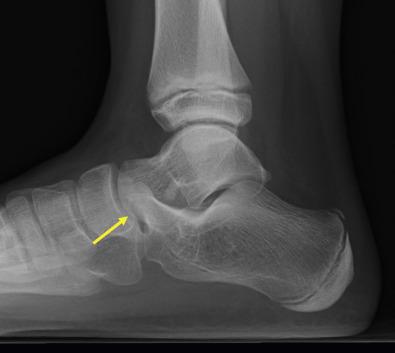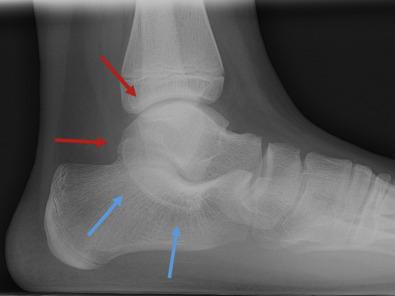Physical Address
304 North Cardinal St.
Dorchester Center, MA 02124
The number of young athletes participating in organized sports continues to expand in the United States, leading to an increasing number of both acute and overuse injuries of the foot and ankle in this age group. The recent trend toward early specialization in one sport poses additional risk for those children engaging in high-level activities. Foot and ankle pain in young athletes requires special consideration, as injuries often involve part of their immature skeleton such as the apophysis or the physis, and long-term function and growth must be considered. In this chapter we focus on the major foot and ankle problems most applicable to the health of younger athletes, including congenital problems, osteochondroses, fractures, and ankle sprains.
A coalition is the term used to describe the adjoining of two or more adjacent bones whose mesenchymal tissue fails to separate fully during normal segmentation in utero. For many people, this coalition may be asymptomatic, and they will never even be aware that they have it. For others, however, the coalition can lead to considerable pain and disability, and they may even require surgical resection with or without realignment—or, rarely, fusion.
Tarsal coalitions may be found in anywhere from 2% to 13% of the population, half of whom will have them bilaterally. They are believed to be heritable in an autosomal dominant pattern. Coalitions can be fibrous, cartilaginous, or osseous. They most often become symptomatic during childhood, when the coalition starts to ossify.
The most common types of coalitions are calcaneonavicular coalitions (CNCs) and talocalcaneal coalitions (TCCs), which each make up about 45% of all coalitions, though the former may be slightly more common. Other, less common coalitions that have been observed include calcaneocuboid, cuneiform-metatarsal, navciulocuneiform, and talonavicular. Although the true gender distribution of coalitions is not known, given their overwhelming lack of symptoms, recent studies have indicated a possible male predominance, with men receiving 50% more surgeries for tarsal coalitions.
CNCs, the most common type, are usually congenital, although they may also arise iatrogenically, posttraumatically, or from other causes.
CNCs present between ages 8 and 12, during which time the foot is observed to stiffen. Patients may present with refractory foot symptoms after an injury, or with frequently recurring ankle sprains. On exam they will likely have diffuse pain, though it may be localizable to the sinus tarsi. Spasming of the peroneal muscles along with a rigid everted foot, called “peroneal spastic flat foot,” may also be seen, though it is not highly specific for CNC.
Anterior-posterior (AP), lateral, and oblique radiography should all be obtained for a suspected CNC, but it will be best seen on an internal oblique view, with an osseous-type coalition being most visible. When viewed laterally, this osseous bridge is called the “anteater nose sign” ( Fig. 27.1 ). Other findings that suggest a CNC in the lateral view are dorsal beaking of the talar head and widening of the talar lateral process. Computed tomography (CT) is not necessary to diagnose CNC, but it has a much higher sensitivity than x-ray and can rule out an accompanying talocalcaneal coalition. MRI may also offer some utility for evaluating nonosseous CNCs. Occasionally the magnetic resonance imaging (MRI) will reveal a stress fracture of the calcaneus or navicular in association with the coalition.

First-line treatment of CNCs should be activity modification and orthoses for medial arch support, escalating to immobilization with 6 weeks of bracing or short-leg casting if needed. Given the inflammatory nature of the pain, nonsteroidal antiinflammatory drugs (NSAIDs) such as ibuprofen will also offer some relief. However, CNCs are more likely to be refractory to conservative treatment than are other types of coalitions. If surgery is required, resection of the coalition is usually successful, with up to 90% of adolescents treated having good outcomes.
TCCs are the other most common type of tarsal coalition. They will present similarly to CNCs, with activity-related pain midfoot occurring at the age of 8 or older. Like CNCs, they may present after an ankle injury, are frequently bilateral, and should be suspected if a patient has recurring or persistently painful sprains. However, TCCs may present slightly later than CNCs, continuing to manifest beyond the age of 12 and into the mid-teens. On physical exam, the oversized medial talocalcaneal facet may be felt distal to the medial malleolus, and pain may localize to the sustentaculum tali.
Imaging of a suspected TCC will also include radiographs, but it is typically best seen on a Harris heel view, which is taken posteriorly at 45 degrees below horizontal, aiming down the calcaneus, and offers the clearest view of a TCC. On the lateral view, a TCC will often show a C-shaped line connecting the talar dome and sustentatculum tali, called the “C sign,” which is present in up to 83% of cases ( Fig. 27.2 ); however, this sign is also present in nearly half of flexible flat feet without TCCs. CT will confirm the diagnosis and determine what portion of the subtalar joint is involved. An MRI will be helpful in cartilaginous or fibrous coalitions. Typically, excision is the first-line treatment, offering perhaps the best return to full activity, while arthrodesis is considered once more than 50% of the subtalar joint is involved. Occasionally the foot deformity that remains after coalition resection requires calcaneal or midfoot osteotomies for realignment.

Pes planus (or flatfoot) is typically an asymptomatic deformity in which the medial longitudinal arch of the foot is noted to be low or absent altogether, with associated valgus of the hindfoot and forefoot abduction. The mechanism of flatfoot is thought to occur from either reduced strength of the longitudinal arch musculature or altered intrinsic structure of the bone-ligament complex. Flatfoot presents in two general types: (1) flexible flatfoot, which represents a normal anatomic variant and almost always responds to conservative management, and (2) rigid flatfoot, a less common and more painful condition that may require correctional osteotomy. Congenital calcaneovalgus and congenital vertical talus may also cause flat feet in children, but both of these conditions present long before children reach the age of sports participation.
Flatfoot has a much greater prevalence in children than in adults, as nearly 100% of infants lack a medial arch from the ages of 0–2. However, the condition decreases throughout development, with only 9.1% of children still having flat feet at age 7. The direct role of sports participation on flatfoot is unknown. Children with obesity have been found to have a threefold greater incidence of persistent flatfoot. Generalized joint hypermobility, which is frequently observed in dancers, gymnasts, and divers, has also been associated with flatfoot.
A number of physical examination maneuvers can help to identify the specific type of flatfoot. First, when the child is sitting with the legs dangling or when the hallux is dorsiflexed, the flexible flatfoot should show restoration of a medial arch, whereas rigid flatfoot will look no different from how it does while weight-bearing. Second, a flexible flatfoot will have arch elevation and realignment of the hindfoot valgus when the patient stands on tiptoes, whereas a rigid flatfoot will remain flat and valgus. The Silfverskiold test can also help to identify an Achilles contracture, which is more likely to cause pain in the flexible flatfoot. Passive dorsiflexion of <10 degrees with a neutral hindfoot in both knee flexion and extension suggests tightness of the entire Achilles tendon, whereas an increase in dorsiflexion with knee flexion suggests tightness of the gastrocnemius alone. Imaging is not indicated for the asymptomatic flexible flatfoot, but weight-bearing AP and lateral radiographs may help to distinguish symptomatic flatfoot from other causes of foot pain such as coalitions and accessory naviculars.
Treatment for flexible flatfoot should typically center on education and reassurance. The evidence for orthoses or shoe modifications in flatfoot is lacking, and it may actually exacerbate pain in a rigid flatfoot or tight Achilles tendon by increasing pressure on the medial midfoot. Thus, painless pes planus should merely be observed. However, athletes with persistent pain from flexible flat feet can start with over-the-counter orthotics prior to custom orthoses, for arch support. Flatfoot can also cause asymmetric wearing of the medial sole of the shoe, and so worn-out shoes should regularly be replaced in order to assure appropriate footwear. Athletes with flexible flatfoot and tight Achilles tendons may also benefit from regular heel cord stretching.
Surgical treatment of symptomatic flatfoot should proceed only when significant pain and disability persists after prolonged conservative therapy. Osteotomies are the treatment of choice when indicated, as tendon transfers and lengthenings in isolation alone are rarely successful, and arthrodesis introduces undesirable complications. Calcaneal lengthening osteotomy corrects the eversion deformity and can be performed concurrently with Achilles lengthening, which may be informed by an intraoperative Silfverskiold test. It has satisfaction rates over 90%. Alternately, the combination of calcaneo-cuboid-cuneiform osteotomy, via closing wedge osteotomies of the calcaneus and cuneiform and an opening wedge osteotomy of the cuboid, creates compensating deformities for the hindfoot valgus and has been shown to have comparable results.
The pediatric form of hallux valgus is distinguished from the adult type by the presence or absence of an open physis. However, up to half of all adult bunions are believed to have begun during adolescence and not become symptomatic until later on.
Hallux valgus typically presents with a prominence over the medial first metatarsal phalangeal joint, with pain being a secondary complaint. It is often bilateral. In children there is a strong female predominance, with a ratio of 4:1 and a known matrilineal component to the disease. Pediatric bunions tend to skew toward younger children, with about 50% presenting younger than 10.
Examination of pediatric hallux valgus should include evaluation of other causes of foot pain, associated foot pathologies, and examination of shoewear. A great toe deformity may be called a hallux valgus if the angle between the axes of the first metatarsal and proximal phalanx is 15 degrees or more in the AP view. Medial skin thickening or callus formation may also be seen over this area. Imaging should include weight-bearing AP and lateral radiographs and a nonweight-bearing (NWB) oblique radiograph. Hallux valgus angles much larger than 15 degrees may be seen, but the angle size does not always correlate with severity of symptoms, and a steep angle itself is not an indication for surgery. A common underlying mechanism is varus of the first tarsometatarsal joint or first metatarsal itself, which then leads to the observed metatarsophalangeal (MTP) protrusion. Metatarsus primus varus is defined as an intermetatarsal angle between the first and second rays of >8 degrees. Potential factors such as ligamentous laxity, pes planus, disproportionate mobility, or length of the first ray may predispose a child for metatarsus primus varus.
Young athletes presenting with painful hallux valgus should first undergo conservative management. Tight-fitting shoes are often the cause of pain, and thus trialing wide box shoes that accommodate the shape of the foot can help to alleviate symptoms. Ibuprofen and activity modification may also provide relief. There is limited evidence for the use of orthotics or bracing, outside of one series that found foot exercises and nighttime splinting were effective in half of those treated and had a low recurrence rate. The authors prefer conservative treatment with shoewear modifications. Children, adolescents, and parents who are bothered by the appearance alone should be counseled that surgery for bunions has a high complication rate and is not recommended solely for cosmetic treatment. For those young athletes who do require operative intervention, it is recommended that intervention be postponed until skeletal maturity, as recurrent deformities are higher with earlier intervention.
Become a Clinical Tree membership for Full access and enjoy Unlimited articles
If you are a member. Log in here